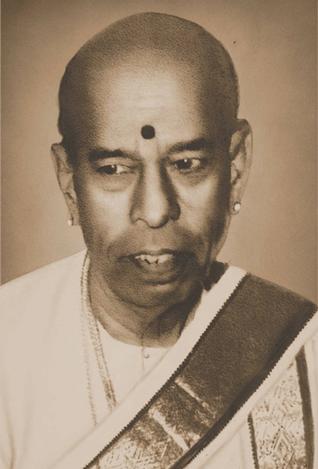A Celebrity in His Time

June 27, 2013: In 1954, what had till then been the President’s Award for performing arts became the Sangeet Natak Akademi Awards. The first Carnatic music recipients of the award in its new avatar were Mysore Vasudevachar and the flautist, Palladam Sanjeeva Rao. The awards were given on March 31, and Sanjeeva Rao unlike the elderly Vasudevachar, collected his in person.
April 1954 was given over to celebrating his receiving it. The Hindu followed his triumphant progress. Celebrations in Coimbatore were the first. The Akila Bharata Madhva Maha Mandal organised a public procession on the 16th, which culminated at the Gopalaswami Temple, where a ‘citation in Canarese’ was presented to the artist. Between 21st and 23, Kumbakonam had no less than three felicitations. On the 21, it was at the Bhajana Mutt where violinist Rajamanikkam Pillai, composer Papanasam Sivan and Harikatha exponent Vadiraja Bhagavatar spoke in his praise. The next was at the Vani Vilasa Sabha and on the 23, it was at the Sathguru Thyaga Brahma Samajam.
On April 25, it was the turn of Sri Krishna Gana Sabha, Chennai. In the presence of C. Subramaniam, Finance Minister, Government of Madras, Mr. Maharajapuram Santhanam, General Secretary, presented to Mr. Sanjeeva Rao, an address on behalf of the Sabha. Two months later, Bangalore welcomed the artist and the Gayana Samaj conducted an event to honour him on June 27. The Madhwa Mahajana Sabha, Tiruchi, celebrated his award on November 22, 1954.
All this notwithstanding, it could not be denied that the reigning monarch of the flute by this time was T.R. Mahalingam aka, Mali.
Sanjeeva Rao had however, had his heyday, till the mid 1940s at least. Born on October 18, 1882, at Palladam, he came from a family known for learning. His father Venkobachar was a Sanskrit scholar who was famed for his healing powers. He rose to fame when he healed Shatkala Salem Narasayya, a zamindar known for his musical talents. The latter had ostensibly been the victim of black magic at the hands of Ramaswami Sivan, elder brother of Maha Vaidyanatha Sivan. Venkobachar set matters right and the grateful zamindar offered to impart his musical talent to one of Venkobachar’s sons. The elder and visually challenged Prananathachar was selected for this but in the event, it was Sanjeeva Rao who benefited.
Performance at 12 years
With Narasayya passing away a couple of years later, the family moved to Madras where Karur Devudu Aiyar taught the young Sanjeeva the violin. He continued training under Sirkazhi Narayanaswami Pillai. By 12, he had begun performing. However, attending a flute concert by the blind artist Sarabha Sastri was to transform Sanjeeva and his brothers. All three apprenticed themselves under Sastri and moved to his native town of Kumbakonam. The tutelage was for seven years during which the brothers subsisted on unchavriti (singing and seeking food). Sanjeeva Rao emerged the real star and in recognition of this was given the Guru’s personal flute when the latter passed away in 1904.
Hailed as Sarabha Sastri’s natural successor, Sanjeeva Rao was to have an extremely successful career. Several gramophone recordings of his were released. He was an important functionary of the Chinna Katchi, one of the two rival organisations that conducted the Tyagaraja Aradhana in Tiruvaiyaru. In 1943, the Music Academy awarded him the title of Sangita Kalanidhi.
E. Krishna Iyer in his Personalities in Present Day Music (1933) summed up his style as follows: “Within limits, he has broad plans and varied imagery, while he steers clear of intricacies and profundities. Mr. Rao is not noted for any great stock in the matter of compositions of various kinds. But what he touches is turned into grape and honey.” In short, good wholesome music.
And then Mali turned up. The two met in the 1930s when Mali’s father brought the child for a personal audition. Within a few minutes Rao left, outwardly angry but inwardly shaken. He declared that what he had heard was not the flute and the boy would do well to look elsewhere for a career. But he knew that Mali was demonstrating what was till then considered impossible on a flute – complete fidelity to the vocal style. Mali went on to become an erratic but brilliant star. Rao’s career hit a plateau thereafter. Mali characteristically neither forgot nor forgave Rao for the initial snub.
Having trained disciples such as Palladam Nagaraja Rao and Tiruchi Ramachandra Sastri, Sanjeeva Rao passed away on July 11, 1962. His friend Musiri Subramania Iyer penned a tribute in The Hindu dated July 12. But a more lasting tribute is the rendition of ‘Chetulara’ by all the flautists at the Tyagaraja Aradhana each year. That was a tradition begun by Sanjeeva Rao and it has endured till today.
Source: The Hindu, DT. June 27, 2013.







